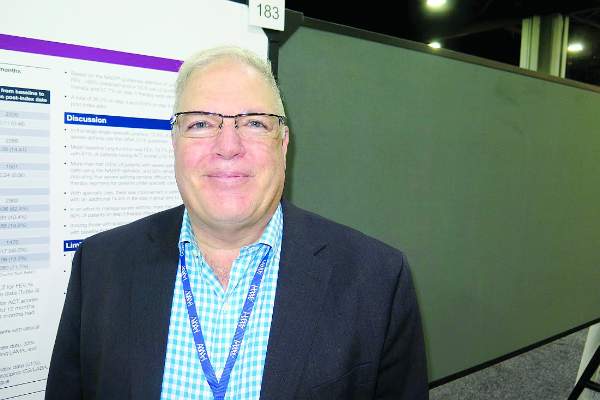AT THE 2017 AAAAI ANNUAL MEETING
ATLANTA – More than half of patients severe asthma have disease that remains uncontrolled at their index date of treatment, and 39% remained uncontrolled at 12 months of follow-up, results from a large single specialty practice study showed.
“Severe asthma accounts for only 5%-10% of all asthma [in] patients but at least half of the health care costs, and it’s a significant burden to those who suffer from it,” study author Brian D. Stone, MD , said in an interview at the annual meeting of the American Academy of Allergy, Asthma, and Immunology.
In an effort to describe the clinical burden among patients with severe asthma treated in a specialty care setting, Dr. Stone and his associates retrospectively reviewed the medical records of 12,922 patients, aged 12 years and older, who were treated between Jan. 1, 2010, and April 30, 2016, by Allergy Partners, Pa., a large single-specialty practice with 106 locations in 20 states. The patients were receiving Global Initiative for Asthma (GINA) Step 4 or 5 treatment for asthma, and they underwent lung function testing (forced expiratory volume in 1 second [FEV1] and FEV1% predicted prebronchodilation) and symptom control assessment with the Asthma Control Test (ACT) at baseline and at 12 months’ postindex date.
The mean age of patients was 44.4 years, 67% were female, 78% were white, 77% had concomitant rhinitis, 21% had sinusitis, and 44% had allergic sensitivities. The mean baseline prebronchodilation FEV1 and FEV1% predicted were 2.45 L and 79.7%, respectively. The mean baseline ACT score was 17, with 61% of patients having ACT scores of 19 or lower, indicating poor symptom control.
Using National Asthma Education and Prevention Program criteria, the researchers found that 52% of patients had uncontrolled asthma at the index date and 39% remained uncontrolled at 12 months of follow-up. In an effort to better manage their severe asthma, more than one-third of patients on Step 4 therapy and 60% of patients on Step 5 therapy changed their asthma controller medications during follow-up.
“As an asthma specialist, I hoped that more [of these patients] would have come under control. These are the most difficult patients to treat,” said Dr. Stone, who practices at Allergy Partners of San Diego. “It’s a population that deserves special attention, and interventions are probably going to be on multiple levels, depending on what type of severe persistent asthma they have. More therapies are needed.”
He acknowledged certain limitations of the study, including the fact that patients were treated by specialists in allergy, asthma, and immunology and, therefore, may not represent the general population with asthma.
The study was supported by AstraZeneca. Dr. Stone reported having no relevant financial disclosures.



